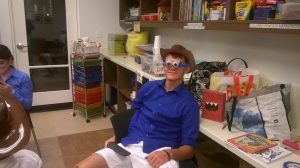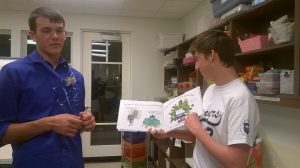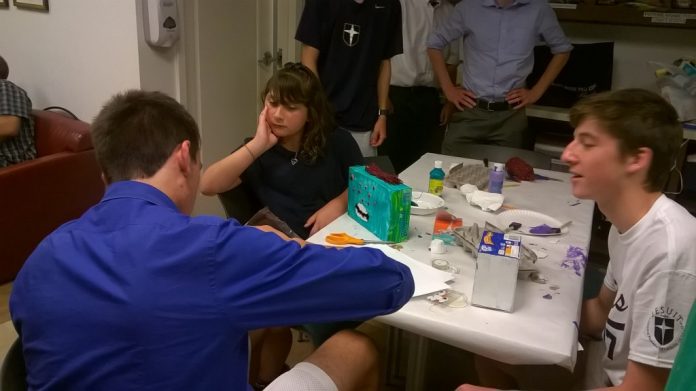Tall shelves lined the average walls of a short-ceilinged room. “Googly eyes,” “hot glue,” “pipe cleaners,” “acrylics;” the bins piled up as far as they reached. However, all lay dormant with the light switch off, patiently awaiting the children to brightly rush in with cheers of jubilation, an surge in artistic creativity. In addition, though inanimate, the materials emitted a vibe of anxiety with the knowledge of Jesuit Interact’s intended visit. White cardboard lured the hot glue gun to affix the googly eyes under pipe cleaner eyebrows. The scissors, slowly rusting after a brief hiatus of usage, tore through cardboard to craft jagged teeth. The glue gun, noticing an opportunity, fulfilled the creator’s desire by affixing the teeth to a gap in the box, surgically whittled by a pumpkin carver. The end product, as the children in the Ronald McDonald House Arts and Crafts Room had envisioned, formed a “cardboard monster,” an idea proposed by Mrs. Gerber.
Around six in the evening, the student race for the white checkered banner, the Ronald McDonald house in this instance, concluded. Immediately putting the idea of the race’s victor behind in the interest of service, the students entered the house with sacks of thin plastic covering material surprises for the children. At first glance, the surprise itself seemed incredibly bland and void of any excitement: white cardboard. However, the “Interact guys are craftier than you might think,” said Mrs. Patricia Gerber, the service group’s moderator.
 The guys may be crafty, but the real creativity in the monsters lay in the hands of the creators themselves, the children. One by one, they entered the room and familiarized themselves with the surrounding materials, elaborating on their ideas as time passed. Googly eyes, clusters of them at times, added a creepy attribute of surveillance. Pipe cleaners or foldable paper extended from the back of the boxes to create eyestalks. Foldable felt stapled to the slim sides of the boxes to form ears. “It was so fun seeing the kid’s faces light up as they stuck on thousands of eyeballs,” Mrs, Gerber remarked. “They attached to Interact and created monster tongues, and as they glued on the final touches of pink hair!” In the end, what began as a white box transformed into a colorful creepy cardboard critter creatively crafted by the children.
The guys may be crafty, but the real creativity in the monsters lay in the hands of the creators themselves, the children. One by one, they entered the room and familiarized themselves with the surrounding materials, elaborating on their ideas as time passed. Googly eyes, clusters of them at times, added a creepy attribute of surveillance. Pipe cleaners or foldable paper extended from the back of the boxes to create eyestalks. Foldable felt stapled to the slim sides of the boxes to form ears. “It was so fun seeing the kid’s faces light up as they stuck on thousands of eyeballs,” Mrs, Gerber remarked. “They attached to Interact and created monster tongues, and as they glued on the final touches of pink hair!” In the end, what began as a white box transformed into a colorful creepy cardboard critter creatively crafted by the children.
 Interact brought more than just crafts, though, and it proved necessary due to competition with puppies that would intrude later on. To remedy the cause of Jesuit service from the bleeding hole of puppy affection, Mrs. Gerber set Halloween tunes to full blast in the hopes that the sound waves would bounce off the rectangular-curved hallways and ceilings and reach children’s’ ears. Jacob Palisch ’17, utilizing his sharp wits, crafted glasses out of an egg carton, string, and construction paper; to introduce a comical aspect to the service experience. Matthew Peracchi ’17 joined in by adhering foam letters to his forehead.
Interact brought more than just crafts, though, and it proved necessary due to competition with puppies that would intrude later on. To remedy the cause of Jesuit service from the bleeding hole of puppy affection, Mrs. Gerber set Halloween tunes to full blast in the hopes that the sound waves would bounce off the rectangular-curved hallways and ceilings and reach children’s’ ears. Jacob Palisch ’17, utilizing his sharp wits, crafted glasses out of an egg carton, string, and construction paper; to introduce a comical aspect to the service experience. Matthew Peracchi ’17 joined in by adhering foam letters to his forehead.
When the hands of the clock neared the “8:30” formation, Interact realized the end was near, so Samuel Olden ’17 decided to leave his mark with a classic scary story (this time without a campfire and creepy dad with a white bed sheet hiding behind the children).
Reception to the event proved overwhelmingly positive among the children, their parents, and Interact members themselves. “Working with the kids at the Ronald McDonald house was definitely a worthwhile experience,” Olden ’17 claimed. Matthew Peracchi ’17 agreed: “It was a fun time for us and the kids.” Indeed it was.






